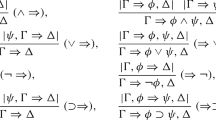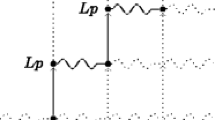Abstract
Let LB be a sequent calculus of the first-order classical temporal logic TB with time gaps. Let, further, LBJ be the intuitionistic counterpart of LB. In this paper, we consider conditions under which a sequent is derivable in the calculus LBJ if and only if it is derivable in the calculus LB. Such conditions are defined for sequents with one formula in the succedent (purely Glivenko σ-classes) and for sequents with the empty succedent (Glivenko σ-classes).
Similar content being viewed by others
REFERENCES
R. Alonderis, Proof-theoretical investigation of temporal logic with time gaps, Lith. Math. J., 40(3), 197–212 (2000).
M. Baaz, A. Leitsch, and R. Zach, Completeness of a first-order temporal logic with time gaps, Theoret. Comput. Sci., 160, 241–270 (1996).
V. Glivenko, Sur quelques points de la logique de M. Brouwer, Bull. Cl. Sci. Acad. Roy. Belg., 15(5), 183–188 (1929).
G. Mints and V. Orevkov, Generalization of V. I. Glivenko and G. Kreisel theorems on a class of formulas of predicate calculus, Dokl. Akad. Nauk SSSR, 152(3), 553–554 (1963).
V. Orevkov, On Glivenko classes of sequents, Trudy Mat. Inst. Steklov., 98, 131–154 (1968).
G. Takeuti, Proof Theory, North-Holland, Amsterdam (1975).
Author information
Authors and Affiliations
Rights and permissions
About this article
Cite this article
Alonderis, R. Glivenko Classes of Sequents for Temporal Logic with Time Gaps. Lithuanian Mathematical Journal 42, 219–231 (2002). https://doi.org/10.1023/A:1020213623847
Issue Date:
DOI: https://doi.org/10.1023/A:1020213623847




